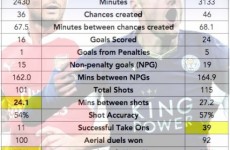- 0
THE SPORTS LAWYER is actually a posse of Britain’s brightest lawyers, from the Sport & Media team at UK law firm, Thomas Eggar, who will be contributing features, analysis and insight on a regular basis on the key sports law issues. In TSL’s latest column, Andrew Nixon and Thomas Barnard discuss Wayne Rooney, Article 17, and what might have been a bargain, maybe
.
.
.
.
By Andrew Nixon and Thomas Barnard
11 November 2010
The recent and well publicised stand-off between Wayne Rooney and Manchester United has, at least for the moment, been resolved, with Rooney committing himself to the club for a further five years. However, the tactics employed by the parties in the negotiations over Rooney’s new contract highlight the importance of decisions from the Court of Arbitration for Sport (CAS) in the Webster and Matuzalem Francelino da Silva cases. They respectively point a) to the bargains available if players quit their contracts in certain circumstances; b) the confusion that surrounds the precise compensation, a confusion that makes such moves unpredictable in more ways that one.
.
Both rulings concerned the level of compensation payable by a player to his club when a player unilaterally decides to leave before the end of his contract. Under Article 17 of the Fifa Regulations for the Status and Transfer of Players, (the “Fifa Regulations”, downloadable here) a player leaving for another club “without just cause” will be liable to pay compensation based on the criteria set out in Article 17(1). Thus the primary aim of Article 17, and indeed the Fifa Regulations generally, is to maintain the stability of the professional football transfer market by imposing potentially costly penalties on players (and clubs) that flout the Fifa Regulations (and club/player contracts) by signing elsewhere before the end of the agreed term.
It is important to note that Article 17 reflects English law in that it deals with breach of contract claims according to the compensatory principle, i.e. by attempting to put the injured party in the position they would have been in had the breach not occurred. However, Article 17 also provides for a “Protected Period” of three years from the date on which the player initially signs with a club. If the player leaves the club outside of the Protected Period, then the compensation payable will be reduced. Limiting, or capping, the pecuniary penalty for early termination means that the player’s value drops considerably. This is a cause for concern for clubs with valuable player assets.
The crucial question therefore is how that penalty is calculated. The Webster and Matuzalem rulings provide the relevant authorities, although their application is far from clear.
.
The Webster decision
In this case, Hearts player Andrew Webster left the club for Wigan Athletic in 2006. He had one year left to run on his contract and Hearts pursued the player for compensation. At first instance, the Fifa Dispute Resolution Chamber ordered Webster and Wigan Athletic to pay Hearts compensation of £625,000. However, CAS reduced the compensation to just £150,000, a figure that effectively represented Webster’s salary pursuant to the un-performed contract.
Given that Hearts had valued Webster at £5m prior to his departure it was a considerable blow to the club. As the law stood, once a player came out of his Protected Period, he was free to sign for a new club for a sum that was well below his market value.
Matuzalem decision: a change of tack
CAS was again asked to rule on the compensation due under Article 17 when Matuzalem unilaterally walked away from Ukrainian club FC Shakhtar Donetsk to join Real Zaragoza in Spain. FC Shakhtar sought to recover some €25m from Matuzalem and Zaragoza which, in view of the reduced sum that was awarded to Hearts in the Webster case, seemed ambitious.
However, CAS eventually determined that Matuzalem was liable to pay his former club €11,858,934, an amount considered to be much closer to Matuzalem’s value on the open transfer market. This represented a reversal of CAS’ earlier decision in Webster. It seemed that now a player would not be able to leave his current club by simply paying nominal compensation.
.
Based solely on the Webster decision, it is possible that Rooney could have left Manchester United by discharging the final year of his salary. This would have amounted to approximately £6m, significantly below the £80m some estimated United could demand for Rooney on the open transfer market. The scenario (and the figure) is somewhat different if the decision in Matuzalem is applied.
Remuneration element
In Matuzalem, CAS considered not just the player’s current salary but also the salary at his new club. It was felt this represented a more equitable mechanism of compensating the club the player wanted to leave. If Rooney left Manchester United it would be fair to assume that his new salary would (give or take) reflect the deal he has recently signed (approximately £200,000 a week, or £10.4m per year). Under Matuzalem any award that would have been made against Rooney could realistically have been around £10.4m. Effectively, Rooney would be obliged to pay the final year of his contract but based on his improved salary as opposed to his current salary.
The value of the services
This means the amount required to “acquire and keep” the player and, in the context of a ‘normal’ transfer, would be the transfer fee. Calculating what that sum might be in Rooney’s case is difficult as the transfer figures were speculative. Taking a hypothetical example, which involves Rooney signing for, say, Barcelona on a five year deal for a transfer fee of £45m, with a £10.4m yearly salary, then amortising the total cost to Barcelona over the term of the contract gives a yearly cost of £9.7m. In line with CAS’ decision in Matuzalem, the yearly cost would be extrapolated over the unexpired term of Rooney’s contract with Manchester United (one year), arriving at a total of £9.7m; a very similar figure.
.
What else could the club claim?
Lost earnings
Under English law, the injured party is able to claim for loss of profits or consequential loss provided that the loss flows from the breach and was reasonably foreseeable at the time the contract was agreed. Accordingly, United would be entitled to argue that it should be awarded a sum to compensate the club for loss of commercial revenue. We can only speculate about Rooney’s commercial value to United; however, it is possible that an additional award could be made in favour of the club, to be added to any sum already payable under the valuation of services or the remuneration elements.
Lost expenses
The Matuzalem decision also gives an indication that a club will be entitled to claim for ‘lost expenses’. Exactly what this will cover is unclear; however, in Matuzalem CAS declined to make an award under this head. The indication suggests that, in the Rooney scenario, Manchester United would be able to recover some of the expenses incurred in training Rooney as well as a portion of the transfer fee paid to Everton FC.
Estimating what Manchester United could recover on this basis is difficult. Further, it would be open to Rooney to argue that the club have benefited from any training costs in the form of on-pitch performance.
So far as the transfer fee paid to Everton is concerned, the most likely approach would be to apportion the £26m fee over the duration of the player’s contract. On this basis, if Rooney’s original contract was for five years, and he terminated after three, Manchester United could claim a further £10.4m (calculated by dividing the transfer fee of £26m by five years and then multiplying it by the number of years remaining under the terminated contract). However, such a claim is not as straightforward in this instance as, since first joining the club, Rooney had already extended his original contract. This might therefore preclude a claim on this basis.
.
There is no limit to the arguments that can be raised by both player and club. However, the remuneration, value of services and loss of earnings would be the key battle grounds.
Perhaps Rooney’s most powerful argument would have been that termination was with just cause, thus taking the claim out of the ambit of Article 17. The success of this line would depend on the number of games Rooney would have played by the end of the season. Under Article 15 of the Fifa Regulations Rooney would only be entitled to unilaterally terminate on the grounds of sporting just cause should he fail to play in more than 10 per cent of games. CAS has however shown some degree of leniency when interpreting the Fifa Regulations (notably in the Webster decision in relation to the time at which a player is entitled to unilaterally cancel his contract) and it may be that had Rooney at the end of the season played in just 25 per cent of games, the compensation he would have paid would be reduced accordingly.
Either way, it is clear that had Rooney left Manchester United he would have had to pay considerable compensation; however, any sum awarded would still have fallen well short of his market value, and that’s where the problem for clubs lie. Indeed, it should also be noted that it is not a case of adding the heads of damage together either: If Manchester United was awarded damages in respect of the value of the services they would not also be entitled to the remuneration element. To do so would not properly represent United’s loss as, on a hypothetical transfer, United would no longer be obliged to pay Rooney’s salary.
In line with decisions of CAS, it is certainly foreseeable that any award could have been between £10m-25m, taking account of the various (and hypothetical) factors, together with the viability of Manchester United’s additional claims. However, previous CAS decisions have been inconsistent and at times arbitrary. Therefore, it is a difficult task for sports lawyers to advise both players and clubs on the likely award.
.













